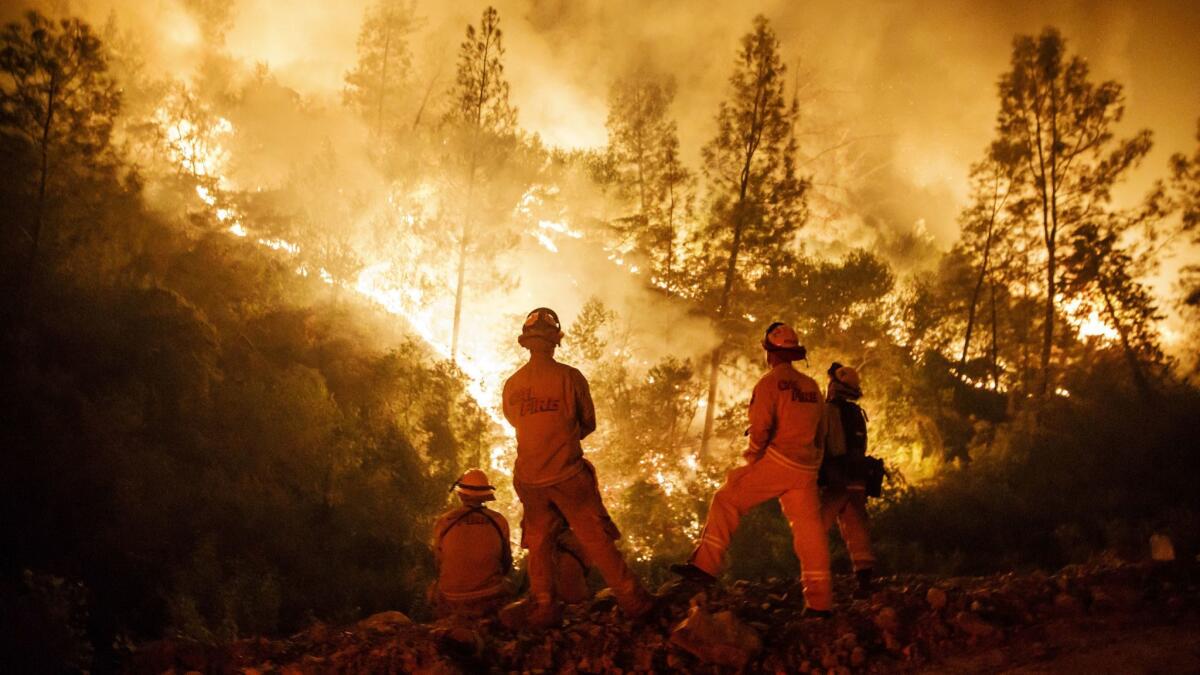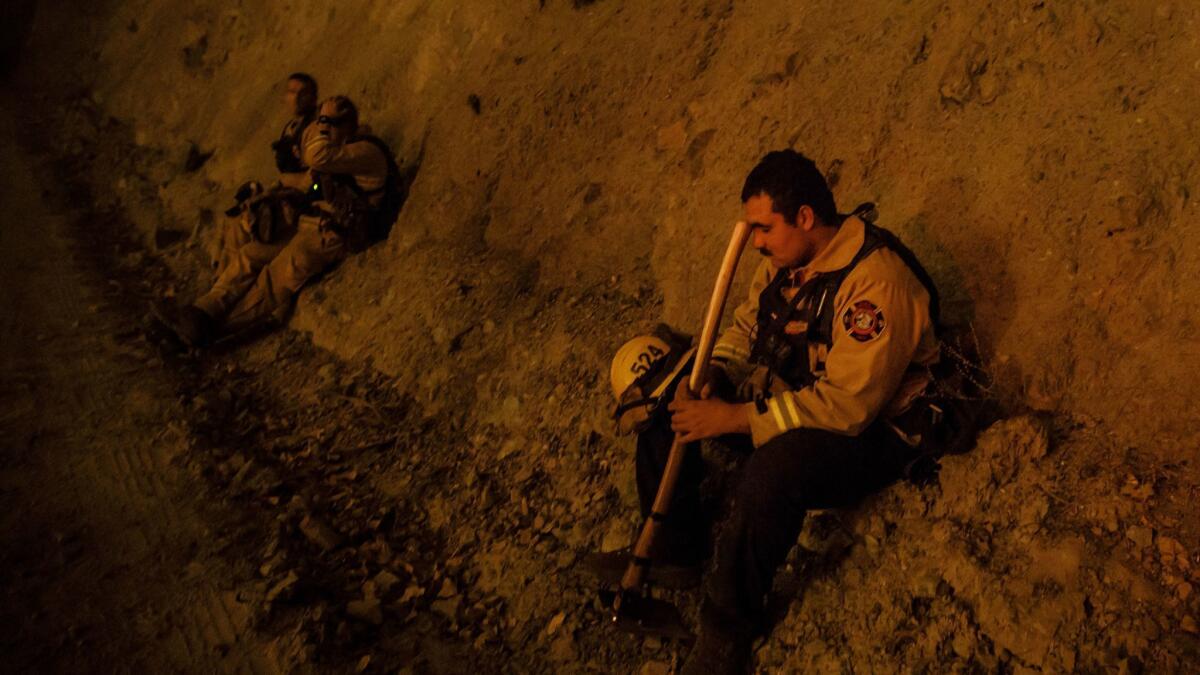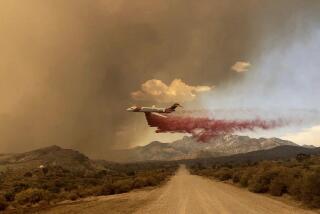They are fighting California’s biggest fire — in steep forest terrain with rattlesnakes, scorpions and poisonous plants

For Trey Rosenbalm and Ariana Altier, fighting the largest fire in California history takes more than just watching out for flames.
The Mendocino Complex fire is ravaging thick brush deep in the Mendocino National Forest, so getting close to the front lines to attack flames directly is almost impossible.
They hike several miles per day up steep slopes wearing hefty gear and carrying heavy bags of equipment on their backs. Then there’s the wildlife they have to watch out for — rattlesnakes, scorpions and poisonous plants.
“You don’t know what your next step is, whether you could go into a ditch or loose brush,” said Rosenbalm, a firefighter with the U.S. Forest Service who like others is working 24-hour shifts every other day.
“You go to sleep tired, that’s for sure,” Altier said.
The remote location is a big reason why the stubborn Mendocino Complex — made up of the Ranch and River fires flanking Clear Lake — raced into the record books. When they exploded nearly two weeks ago above the lake, firefighters were faced with an urgent choice.
California fire coverage: 18 blazes scorch 600,000 acres across the state »
Flames were threatening lakeside communities while also burning rapidly into forestland to the north and west. The fires were among many burning across California, so resources were tight. Crews focused on protecting communities, using bulldozers to cut fire lines above homes in a mission that was largely successful. As of Wednesday night, 119 homes had been lost and no one was killed, a sharp contrast from the destructive Carr fire to the north that consumed more than 1,000 homes and killed seven people.
But the Mendocino Complex fire rapidly moved into forest land, where it was difficult to place firefighters. There the flames burned through dry brush at an unprecedented rate.
“The fire was so unpredictable that it wasn’t worth putting firefighters in the middle of the wilderness,” said Steve Kaufman, a spokesman with the California Department of Forestry and Fire Protection. “There’s no way to drive fire engines to the middle of the forest.”
Kaufman and others said difficult-to-access terrain was a major factor in the unprecedented size of Mendocino Complex, which topped more than 300,000 acres as of Wednesday afternoon. Unchecked, the fire was able to push through rolling tree-covered hills, flat grassy land and rugged canyons.
“There’s nearly every type of fuel you can imagine: timber, thick brush, light flashy fuels,” said Ron Oatman, a Cal Fire spokesman.
Dmitri Menzel, a battalion chief with the Novato Fire District, said working on a fire that’s burning in remote areas is exhausting.
“It’s dirty, it’s dusty. You drive miles and miles to just get to the fire’s edge,” he said.
On Wednesday, he was working on the River fire, which had no movement overnight and was 81% contained by dusk.
“It’s a more relaxed day for us,” he said. “A little less work, but we’re still maintaining diligence. The intensity of the fires in these last few years is pretty extreme.”

Longer, hotter and more destructive fires are leaving California firefighters exhausted, dealing with new stresses that they didn’t have to experience 10 years ago. Firefighters are being pulled up and down the state to different fires at unexpected moments and spending more time out in the field — up to a month or more — without seeing family members.
“Being away from home is rough,” Kioni Sodaria, a firefighter from the Central Calaveras fire department. “You got to tell yourself, this is what we have to do.”
With a fire that’s burning in more remote areas, there are also fewer opportunities to use man-made barriers to stop the flames, Oatman said. And firefighters have to adhere to federal laws that protect the forest.
For instance, they need permission to use bulldozers and other mechanized equipment, which is a process that takes time, said Paul Gibbs, spokesman for the multi-agency fire response.
“The agencies take that very seriously,” Gibbs said. “They want to make sure other opportunities have been looked at.”
After the first few days, the Mendocino Complex fire began threatening more communities along Clear Lake. But by then, firefighters had prepared, building fire lines with bulldozers and using aircraft to dump more than a million gallons of fire retardant on the mountain ridges towering over the towns of Lucerne and Nice.
“Those fire lines are doing pretty good right now. Most are holding pretty well,” said Mitch Bosna, a spokesman with Cal Fire.
From his Lucerne home, Larry Wiedey watched the flames, which seemed to be raging just blocks away.
“I would’ve thought that was it,” he said. “I thought, we have to get the hell out of here.”
Camping out in a Kelseyville evacuation center early this week, he thought he’d lose his home. But he was amazed to learn later that firefighters kept the fire from coming down the slopes into the town.
Now that they have more of a handle on the fire near residential areas, the focus is shifting to securing fire lines ahead of the blaze to the north. That means continuing to dig lines with hand crews and bulldozers and being prepared to hose down the area. Firefighters are also setting back fires to get ahead of out-of-control flames and burn out their fuel.
More than 14,000 firefighters are battling more than a dozen major wildfires raging up and down the state that have charred more than 644,000 acres and made this one of the worst fire seasons in California. It recently turned into an international battle, with firefighters from Australia and New Zealand joining crews this week at the front lines.
“We’ll see at the end if it will become the worst,” said Jonathan Cox, battalion chief and public information officer with Cal Fire’s communication office. “We’re pretty early on in peak fire season until we get rain. Each day that passes, the fire fuels will get drier.”
Near Redding, the Carr fire continues to burn in steep terrain, consuming timber as firefighters keep building fire lines ahead of the flames. The blaze has burned 176,069 acres and is 47% contained.
Near Yosemite National Park, firefighters made significant progress on the Ferguson fire, which is at 94,992 acres and 68% contained. Yosemite Valley, one of the park’s main tourist draws, remained closed to visitors, while some roads were reopened.
The Holy fire in the Cleveland National Forest pushed closer to some homes, prompting a new round of mandatory evacuations. While 15,000 residents are still displaced from their homes, fire experts worry the worst is yet to come as Southern California will soon see Santa Ana winds resurfacing and potentially creating fire threats while the blazes up north continue to burn.
“We’re hoping we can get control of the fires and get our crews off the fire lines, get them to rest before the next fire breaks out,” Cox said.
J Olsen, a firefighter with the Central Calaveras fire department, said the fires are a never-ending battle.
“It’s a marathon that just keeps getting longer and longer,” he said. “Every season I go into it thinking it’s going to be the worst season we’ve seen yet.”
alejandra.reyesvelarde@latimes.com
alene.tchekmedyian@latimes.com
Reyes-Velarde reported from Ukiah, Tchekmedyian from Los Angeles. Times staff writers Ruben Vives and James Queally in Los Angeles contributed to this report.
More to Read
Start your day right
Sign up for Essential California for news, features and recommendations from the L.A. Times and beyond in your inbox six days a week.
You may occasionally receive promotional content from the Los Angeles Times.







